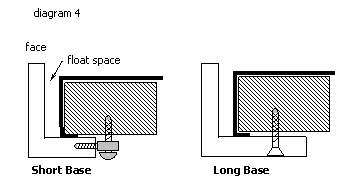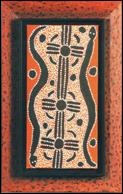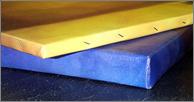
Traditionally, and historically, an unframed painting has been considered incomplete. A picture frame is used to improve or enhance artwork by separating it from the display wall, linking it to room décor, and/or acting as additional support and protection. In order to help prevent the warping of paintings on lightweight wood bars—stretchers or strainer—completed canvases were placed in frames to add support for hanging. During the mid 20th century the display of unframed stretched canvases (see Gallery Wraps below) became very trendy and heavier non-adjustable strainer bars were used to support the canvases intended for display with no frame reinforcement. Such is the case with many of the paintings from the abstract expressionist era.
The practice of stripping was developed during that time in an attempt to help finish off the look of an unframed canvas. It is the application of thin wood strips ¼" to ⅜" thick fitted against the painting along the outside edge of the painting to add support to a lightweight stretcher (diagram 1). This type of frame trim is also called a baguette (photo 1). They are sometimes mitered, but often butt joined and nailed directly into the strainer through the canvas. Unfortunately this type of frame offers little additional support and only serves as a slight visual improvement over no frame at all. The float frame as we know it today evolved from the baguette.

 Photo 1
Photo 1
Thin ⅜" lattice strips are nailed around the outside edges, usually extending top to bottom with horizontal strips butting against them inside.
Float Frames
The standard float frame is an L-shaped moulding profile, that supports the canvas from the back allowing for a float space between the art and the side of the frame (diagram 2). A step float has a built-in stair step with a set float space determined by the design of the profile (diagram 3). The frame base is the back width of the frame that the art actually rests on and L-shaped profiles are available as either short base or long base profiles (diagram 4). Float frames are available in a number of styles, heights, and depths to accommodate a wide variety of canvases and panels.

Unlike stripping, float frames attach the canvases from the back, and depending on the profile base length, some floaters will offer more support and exterior protection than others. The wider the face and longer the base of a moulding, the more bulk, strength, and support it will add to that frame (photo 2). The attachment of the bars to the floater will also determine the added support. Any stretched canvas is significantly better reinforced when screwed through the frame into the back of the bars, and only long base profiles allow for screwing directly into a strainer or panel. Short base profiles require an eye screw mounted horizontally into the moulding base with a vertical round head screw fed through the eye into the panel. There are two reasons the short base is weaker: first, the float frame itself has less structural stability because of the short base, and second, the eye screw assembly.
 Photo 2
Photo 2
The L-shape float supports the canvas from the back allowing there to be a variable float space between the frame and the canvas.
Float Variations
Once the basic concept of float frame installation is understood then variations may be explored in the designing and use of them. Consider a diptych framed in a single floater rather than two side-by-side (photo 3). A wonderful stacked variation in (diagram 5) (L) was designed by Greg Perkins of Larson-Juhl for a museum wrapped original African canvas (photo 4). This design uses the float as a contrast accent, almost like a fillet (slip), atop a modified slant liner profile.
 Photo 3
Photo 3
This diptych has been assembled with a wide ½" float space surrounding and between the two canvas panels.
 Diagram 5
Diagram 5
The stacked variation (R) uses the L-Float as the base with a traditional flat profile screwed atop. This would be well suited to a side-stapled stretched canvas.
 Photo 4
Photo 4
A stacked float was used for this original African painting, museum wrapped with the sides painted black by the artist. Photo courtesy of Greg Perkins, Larson-Juhl.
Gallery Wraps
Stretched canvases are available three ways: as traditional stretch, museum wrap, and gallery wrap. A traditional canvas is about ¾" thick with the canvas having been stretched over adjustable bars and stapled or tacked to the sides. This makes a traditional stretched canvas never a finished look, requiring a frame with a rabbet (rebate) to properly be displayed.
A museum wrap is a canvas wrapped over deeper 1-½" to 2-½" non-adjustable strainer bars. The artist's canvas is stretched clear around to the back of the bars with no visible staples on the side. Although the canvas wraps around the sides, the painting stops at the top edge leaving the sides of the prepared canvas which may be painted white or black. A contemporary gallery wrap—most commonly used with open edition or print-on-demand giclée prints—is also on deep 2" bars having been stapled to the back, but the image continues clear around the sides to the back edge (photo 5). The museum and gallery wrapped deep canvases are perfect for float frames and their assorted variations. Also notice the worn ink at the folded corners of the blue gallery wrap in photo 4. A float frame would hide the corner rubbed ink making the art far more finished.
 Photo 5
Photo 5
A stacked float was used for this original African painting, museum wrapped with the sides painted black by the artist. Photo courtesy of Greg Perkins, Larson-Juhl.
With the onset of digital printing, the ability to print directly to canvas, and the concept of print-on-demand, the sales of open edition art canvases and the practice of gallery wrapping has flourished. For a number of years home décor has whole heartedly embraced the totally unframed gallery wrap, but more recently these canvases are being finished with a modified back edging support I refer to as a back float.
Back Float
I first saw the back float used at winter Las Vegas Market 2008 held at World Market Center. Many gallery home décor wholesalers began showing the deep gallery wrapped canvases that had been simply mounted to a ¼" to ½" thick by 3-4" wide flat stained or painted piece of wood. The wrap was screwed to the top of it giving it a slightly more finished presentation (diagram 6). There were also stacked versions with very simple solid block placement giving an added dimension.

With the inconsistency in quality of available bar materials and the continued preference by artists for unframed gallery wraps, there is an increasing problem with large canvases becoming warped. These are not bowed as in bowed mountings, but rather a twisting of the bars causing a corner to corner warp. A British artist, Leon Leigh, who is both a metal sculptor and oil painter has been experiencing this twisting in his 5' x 6' x 2-½" deep gallery wrapped canvases. As a solution he has begun to build fabulous ¼" x 3" flat, steel frames to back float his paintings. They are fused and finished so they look like one solid piece of steel and are screwed solidly to the back of the strainers. It has eliminated the twisting issues as well as unified his paintings to his 4' free standing sculptures by introducing the same material.
Final Frame
Framers must keep up with the needs of today's art and always think outside of the box when designing. The way to stay one step ahead of your competition is to offer what other bespoke framers might not be. Though originally designed for canvases, float frames are also the logical moulding choice for cradled panels and 1" deep solid hardboards often used for encaustic painting—but that's another article. Using float frames and stacked moulding combinations will not only set you apart from the competition, but will assure you greater profits. Two frames are always better than one.
END
Copyright © 2010 Chris A Paschke
For more articles on mounting basics look under the mounting section in Articles by Subject.
Additional information on all types of mounting is found in:
The Mounting and Laminating Handbook, Second Edition, 2002,
The Mounting And Laminating Handbook, Third Edition, 2008 and
Creative Mounting, Wrapping, And Laminating, 2000 will teach you everything you need to know about getting the most from your dry mount equipment and materials as an innovative frame designer.
All books are available from Designs Ink Publishing through this website.
Chris A Paschke, CPF GCF
Designs Ink
Designs Ink Publishing
785 Tucker Road, Suite G-183
Tehachapi, CA 93561
P 661-821-2188
chris@designsinkart.com